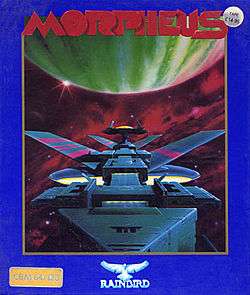Morpheus (1987 video game)
| Morpheus | |
|---|---|
 Cover art | |
| Developer(s) | Graftgold |
| Publisher(s) | Rainbird |
| Designer(s) | Andrew Braybrook |
| Platform(s) | Commodore 64 |
| Release date(s) | 1987 |
| Genre(s) | Shoot 'em up |
| Mode(s) | Single player or two players |
Morpheus is a 1987 shoot 'em up computer game published by Rainbird and developed by Graftgold for the Commodore 64. The game's designer Andrew Braybrook wrote a series of articles on the game's creation for the magazine Zzap!64 over an 8-month period.[1]
Summary
It had very realistic graphics, despite the limitations of the C64. It was also notable in that the ship was customizable. Features such as auxiliary weapons and "systems" (put into the expansion ports) allowed for a variety of different possibilities. Energy and shield generators, detection devices, even electronics counter-measures (ECM) pods were available for the onboard ports, and weapons slots accommodated guns, remote drones, and disruptors (hit everything on screen). The game had a wide variety of enemies (known as "morphai") who had differing appearances, and in some cases evolved as the game went on (e.g. an enemy that is first encountered randomly drifting the first time it's spotted will later have the ability to shoot). Their names were generally taken from lesser known entities in Greek mythology, or at least had Greek names (such as Thanatos, a green pulsating enemy that can be deadly with its relentless attack). The levels are also divided into two "phases", or parallel dimensions, Positive and Negative, which effect the increase or decrease of the ship's "charge." Some enemies have a different appearance, and the way of destroying the primary "Orbital" enemies is different. In the Positive Phase charge is extracted, in the Negative Phase it's deposited, when blasted with the Plasma guns (immune to all other weapons).
Reception
The game was positively reviewed by Zzap!64 magazine who awarded it a Sizzler rating with an overall score of 90%. It was described as "without doubt one of the most finely constructed games ever written for the 64." The graphics were praised but reviewers noted that the gameplay style was a significant departure from Braybrook's previous games so recommended that readers try the game before purchasing, as although technically accomplished it might not appeal to everyone.[2]
References
- Morpheus entry at Lemon 64
- Images of Morpheus box and manual at C64Sets.com